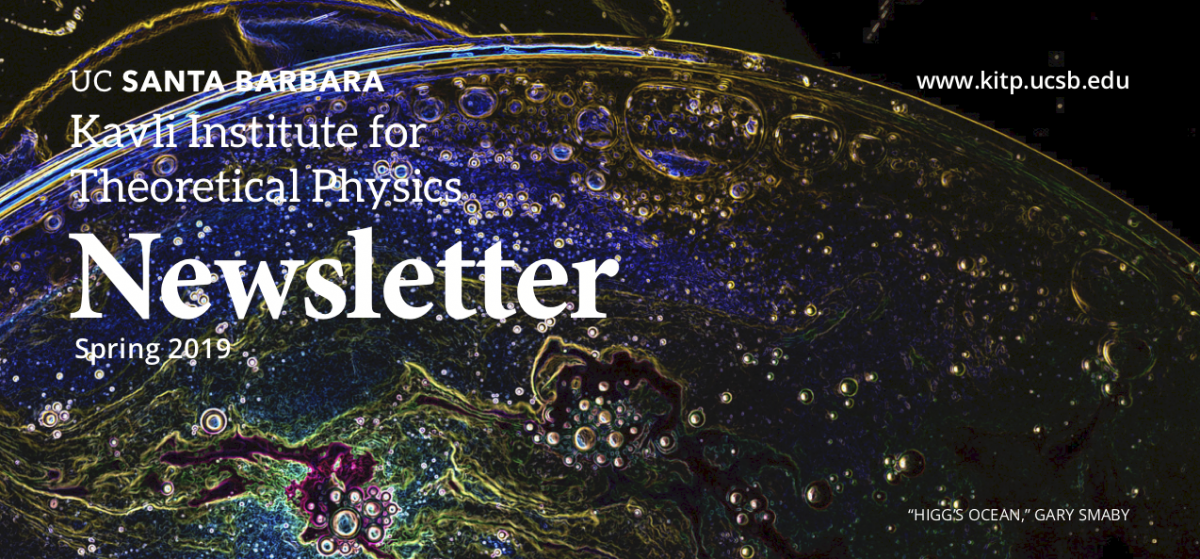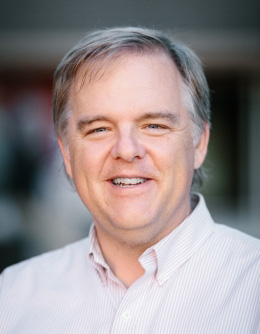
 Lars Bildsten.
Lars Bildsten.
Photo by Jakub Ostrowski.
Our cover image for the Spring Newsletter is from Gary Smaby, a long-time KITP friend and supporter. Gary worked closely with us during the construction of the Munger Residence and, in collaboration with KITP Artist in Residence Jean-Pierre Hebert, led the production and placement of art in the new building. Once everything had been completed it was clear that there was just one thing missing: Gary's art! This Spring, we were able to work with him to select, produce and hang many of his pieces throughout the Munger Residence. These range from his remarkable black and white photographs of 70's rock legends in our music practice room to his wonderful abstractions of photographs of everything from lichens to astronomical nebulae. The image above is in Glenn's Game Room complementing the cool, classic Pin-Ball machines in the room donated by Glenn Duval. Glenn’s Game Room was just named in recognition of Glenn and Bettina Duval’s generous support of KITP Graduate Fellows.
Our new Residence Manager Carlos Marquez has been with us for eight months, and his story of rising up through UCSB's well-run Housing operation here is an inspiring read. Another great story from the Munger Residence features Estelle Inack, a visitor originally from Cameroon who noticed that we were missing her national flag in the Hall of Flags. Click here to find out how our Residence team was able to save the day!
Our faculty continue to be very impactful. Starting in 2019, David Gross, KITP Permanent Member and Chancellor's Professor, has taken on the role of President of the American Physical Society, the premier organization in service to the US Physics Community. This prestigious position is giving David the opportunity to shape the future of the physics community while also working to ensure that Congress and other government agencies support basic research! Leon Balents, KITP Permanent Member and Yzurdiaga Professor, was elected to the National Academy of Sciences in early May 2019 and will also serve as a Co-Director of the Canadian Institute for Advanced Research's Quantum Materials program. Don't worry, Leon's not moving to Canada! Rather, this will give him additional opportunities to shape international research.
Led by Boris Shraiman, KITP Permanent Member and Gurley Professor, the KITP has enabled new scientific interactions between biologists and physicists. The most intense events we hold are the yearly Santa Barbara Advanced School of Quantitative Biology. Always held in conjunction with a KITP scientific program, this summer school allows for an exploration of novel research questions while learning new laboratory techniques. Read a story written by one of our long-term participants, Dr. Honour McCann, about the prolonged exploration of an epiphyte (a plant that grows on the surface of another plant) on kiwifruit. This involved both field work (in Nipomo) and later lab work. Enjoy reading about the path of research they discovered!
Programs at KITP bear scientific fruit on long-timescales. A long-standing fundamental challenge in astrophysics is to definitively associate astrophysical events with the forging of the chemical elements. Jennifer Johnson tells her story about a KITP conference she attended in 2008 where she and Inese Ivans found a way to visually clarify where these elements are made in the Universe. Their work is now the classic display tool of these complex origins.
Another example of prolonged effort is the note written by Deputy Director Mark Bowick on the now famous Sachdev-Ye-Kitaev (SYK) model for strongly interacting quantum systems and its correspondence to a two-dimensional model of gravity. A pure theoretical result, it's these kind of stories we theorists love!
A large part of KITP's mission is in identifying and supporting early-career scientists to participate at KITP for prolonged periods of time. We invite more than a dozen graduate students every year to be with us for six months as Graduate Fellows, and we hire 3-5 new postdoctoral Scholars (i.e. postdocs) every year. The postdocs are with us for about three years, allowing them to engage in nearly 30 scientific programs and meet thousands of physicists. KITP faculty provide mentoring with the goal of enabling these postdocs to use their time with us to define their own research agenda and scientific path. Read the story of two such postdocs, Daniel Holz and Scott Hughes, who were with us over fifteen years ago. The classic paper they wrote, entitled: “Using Gravitational-Wave Standard Sirens” has been cited over 250 times, and, most importantly, laid the ground-work for a new approach to measuring the expansion of the Universe that was first performed last year with the detection of the merger of two neutron stars. It's an amazing story of collaboration!
In closing, I want to update you on one important development for the Santa Barbara community. A participant in our "Physics of Dense Suspensions" program, Douglas Jerolmack (U. Penn), was here during the Montecito debris flow of January 9, 2018 and carried out immediate field work with Professor Thomas Dunne of UCSB's Bren School. Since then, Professor Dunne has received funding from a Montecito resident that is allowing for their collaborative work to continue. They now have a postdoc who is examining the complex flow behavior of the materials that made the debris flows to determine how burned soil may be different from unburned soil. Results are not out yet, but we will be sure to let you know what they have learned when the time is right.
~ Lars Bildsten, KITP Director
KITP Newsletter, Spring 2019
